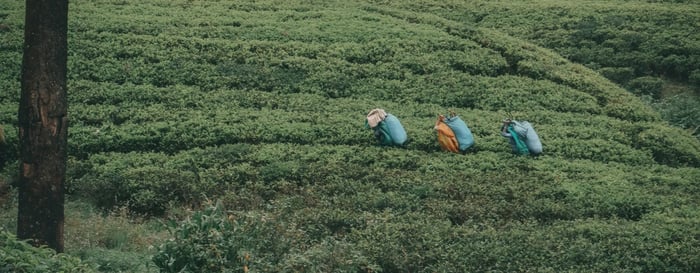I wouldn’t say that we were at the edge of Singapore, but the road literally ran out. After leaving the highway we had managed to zigzag our way through an industrial estate it was almost as if our taxi had turned into a DeLorean and we had also gone back in time. There was just one giant blue and white ceramic pot that stood on the roadside, which showed us we were in the right place. We were getting close to the pottery jungle and home of the famed dragon kiln.
At the end of the last hoarding disguising the building work, we entered a tropical paradise. We discovered a kampong-style village that looked as if it hadn’t changed for decades. Lush forest branches hung over the wooden buildings and long-tailed macques swung between the trees. We were looking at what appeared to be one of the last outposts of life before Singapore discovered skyrise buildings and steel. This was the Thow Kwang Pottery Jungle, which has been home to Tan family for three generations. Mr Tan Kim Seh, who was born in a porcelain village in China, bought the dragon kiln when he arrived in Singapore in the 1960s. At that time ceramics were in their heyday, and Tan and his five children created pots for orchids, cups for the rubber plantations and giant water jars that households would use to store water for bathing.
While there were 30 or so dragon kilns across the island, 20 of the kilns could be found in Jalan Bahar, which was known for its rich clay soil. Tan Kim Seh’s family also dug the clay from the ground. The large hole in the ground would fill with rainwater and his granddaughter Stella would use the natural pond as a swimming pool.
There are just two dragon kilns left in the country. While the Tan family now use an electric kiln to fire their work, twice a year the family will wake the dragon kiln from its slumber. I was lucky to see this 74 year old kiln spark into action and breathe a river of fire once more.

The firing of the dragon kiln as it turns out is less about art and more about science. If the stoker increases the heat too quickly, moisture rushes out of the clay and the pots explode. So the Tan family spend two days drying out the pots on a low heat before they increase the heat to over 1,250 degrees Celsius, when the flames are so hot they start to turn white. While the kiln might almost be an antique, the thermometres that the potters use to take the readings are state of the art.
The work is labour intensive. It takes three weeks to pack the red brick kiln that reaches sauna-like temperatures in the tropical heat and four days to fire the ceramics. From the moment that they light the incense sticks and give offerings of fruit and money to the kiln god, the potters spend every hour eating and sleeping around the kiln to make sure that the temperature of the fire never drops and ruins the works. While they are preserving Singapore’s heritage, the potters explain that the dragon kiln gives them unique results. The spread of ash from the wood, and salt that they throw into the fire, creates unpredictable colours and textures that are unique to each piece.
The Tan family who changed from selling their wares in Singapore exporting them aboard when the ceramics industry started to slow down, were intrigued to see how many people were keen to visit the kiln. Aware that the dragon kiln was an important part of Singapore’s heritage, they decided to offer classes to visitors so they too could experience what it was like to create their own ceramic work. So today I would have the chance to learn from the third generation of artisans who worked the dragon kiln.

As I passed between the sea of Chinese vases, porcelain stools and sculptures, I couldn’t take my eyes of the smouldering giant that lay at the entryway to the pottery. The 30-metre long kiln that snaked its way up the hillside, formed the belly of the beast that ceramicists such as Cultural Medallion Award winner Iskandar Jalil had used to fire their prized works.
It was highly unlikely that I would receive any prizes for my works, but Stella – who has now joined the family business and works full-time teaching ceramic skills to visitors – was insistent that I would be able to create a piece that I could be proud of.

I took a seat in one of the kampong-style buildings that overlooked the pond, where the Tan family had once dug out the clay for their pieces. It felt light years away from the hustle and bustle of the city and as relaxing as any spa.
Stella gave me a piece of damp clay which she showed me how to shape into a bowl. She had already done the hard work prepping the clay, I just needed to smooth it over a mould and then customise it with paints. Alongside the other people in the class, we just quietly decorated our works as the tweeting of birds from the jungle formed the sound track to our experience.
My work wasn’t going to worry Royal Doulton or Lladro, but I had already developed a fondness for my slightly lopsided little bowl. It reminded me of the time that I got to see a quieter side of Singapore and discover the legend that is Singapore’s oldest dragon kiln.
Classic Jordan
- Potter through bustling Amman with its vibrant neighbourhoods and historic sites
- Take in magnificent Petra, marvelling at sites such as The Treasury, Monastery and High Place of Sacrifice
- Spend the night in a luxury camp deep within the Wadi Rum
- Slather yourself with mud and go for a float in the Dead Sea
Oman Cultural Tour
Muscat & the East Coast Nizwa & the Empty Quarter Oman Middle East & North Africa
- Visit the buzzing town of Muscat
- Drive through the imposing Hajar Mountains
- Explore Wahiba Sands and its wildlife
- Visit the picturesque fishing town of Sur
- Spend a night under the stars in a luxury Bedouin encampment
Undiscovered Sri Lanka
Colombo Sri Lanka's Hill Country Sri Lanka's Cultural Triangle Sri Lanka's Eastern Province Sri Lanka Indian Subcontinent
- Enjoy one of the world’s most scenic train journeys from the Tea Country to Kandy
- Discover Sri Lanka’s most revered Buddhist site, the Temple of the Tooth at Kandy
- Marvel at the four UNESCO World Heritage Sites in the Cultural Triangle
- Relax on the pristine, white-sand beaches of Trincomalee
- Enjoy a guided photography tour of Colombo before dinner in a renowned seafood restaurant








